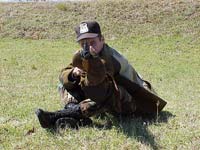
Crossed-Ankle Sitting Position
By SFC Grant Singley, USAMU Service Rifle Team Member
 |
There are two primary variations of the sitting position that are used during Highpower competitions. The variations are crossed-ankled and crossed-legged. This article covers the crossed-ankled sitting position. You may want to try the crossed-ankled position if you have excessive pulse in the crossed-legged position and/or your body type prevents you from getting into the crossed-legged position. I would also like to say that all the cool people to include myself shoot the crossed-ankled position. Note: This article is written from a right-handed shooter’s perspective.
First, the crossed-ankled position is not for everyone. Many people find that their legs are too flexible to keep their knees up off the ground. A quick test is to sit down on the ground, extend your legs and cross your ankles (left over right). Lean forward and place your elbows on your knees as if you were actually holding the rifle. Your knees need to be able to stay up off the ground in order to have enough elevation in your position.
If you find that you are “inflexible” enough to shoot in the crossed-ankled position, I will now walk you through the process.
Put on your shooting coat, grab your rifle and sit down on the ground facing the “target”. Try to set up the position so that your feet and body are pointing straight down range. You may pivot your feet and body slightly to the right if desired.
Your left elbow may be placed somewhere forward of the left knee so that the lower part of your tricep is resting across the knee.
Your right elbow may be placed in the bend of the right knee.
Your non-firing hand and butt-stock placement will vary according to your size/height.
You are now at the point where you must fine-tune the position. Vary the placement of your non-firing hand, butt-stock, elbows and legs until you are steady and comfortable. This may take some time. You can condition your body by getting into this position for 10-15 minutes at a time while watching TV.
To adjust your natural point of aim: Leave your feet in place and slide the seat of your pants left, right, forward or backward as needed.
Once you have dry-fired and feel comfortable in the position, it is time to go to the range and impress your buddies with your new found ability to shoot sitting rapid-fire. You may have to adjust your position to accommodate for the effects of recoil. Your wobble area should be mid-ring 10 or better. Again, this may take some time and experimentation.
A rock solid position will not guarantee a “10X clean” on every string you fire if you do not apply proper sight alignment and trigger control. It is easy during a rapid-fire string to get excited and break shots that are less than perfect. How can I fix that, you ask? My answer may sound simplistic and sarcastic, but here we go……. DON’T BREAK A SHOT UNLESS IT IS SITTING IN THE MIDDLE!!!! The secret is now out and DeMille’s record will fall soon. Seriously, you have plenty of time during a rapid-fire string to let the rifle settle in the middle before pulling the trigger. Work on becoming highly efficient in your shot process so that you can spend the most time possible actually focusing on the front sight and moving the trigger smoothly to the rear. If the rifle does not settle back in the center after a shot, there is nothing stopping you from physically moving the rifle back into the center and then breaking a shot. A slight amount of muscle tension with the non-firing hand and arm is acceptable and may be necessary to keep the sights in the middle after recoil.
I have not mentioned the use of a shooting mat yet. The use of a mat is totally decided by personal preference. I usually sit on the mat with my feet on the ground in front of it. If the firing point has thick green grass on it, you may not want to use a mat, but if the point is hard and rocky, the mat may help stabilize the position.
|
The USAMU Service Rifle Team is also answering your questions pertaining to Service Rifle Shooting including topics such as Equipment and Ammunition, Shooting Positions and Shooting Techniques and Tactics. Go to http://www.odcmp.com/usamu/shooting_tips.htm to view the latest questions and answers. If you have a question you would like to ask, email USAMU@odcmp.com. |